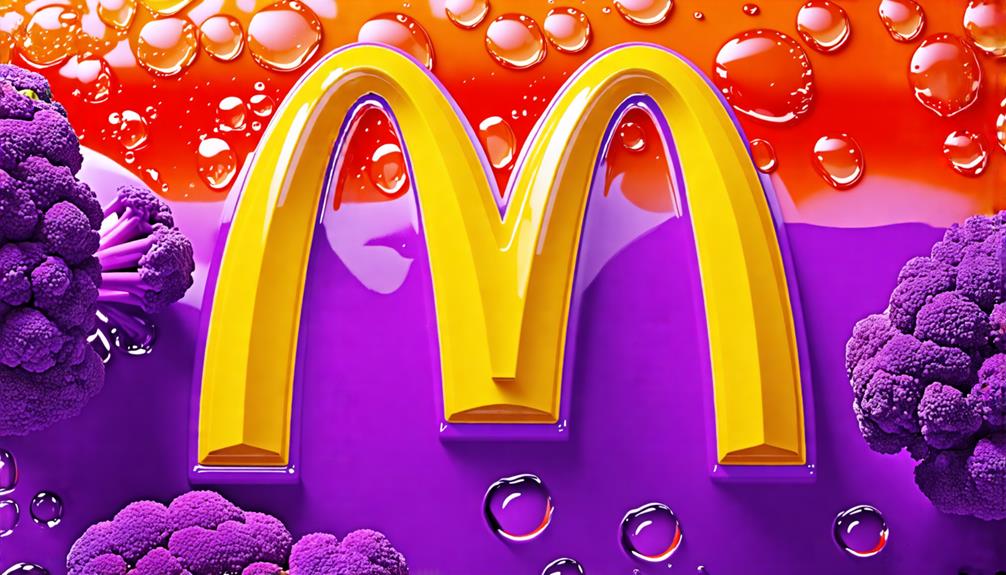You've probably heard of some unusual food combinations, but McDonald's attempt at bubblegum-flavored broccoli might take the cake. In 2014, the fast-food giant tried to make vegetables more appealing to kids by infusing broccoli with a familiar sweet taste. While the idea was innovative, it didn't quite hit the mark with consumers. This bold experiment raises questions about the balance between nutrition and taste preferences, especially when it comes to children's food. What other creative approaches might work better to encourage healthier eating habits? The answer may surprise you as we explore the complexities of food innovation and marketing.
Key Takeaways
- McDonald's experimented with bubble gum-flavored broccoli in 2014 to encourage children to eat more vegetables.
- The initiative was led by then-CEO Don Thompson as an innovative approach to Happy Meals.
- The unusual flavor combination aimed to make vegetables more appealing to young customers.
- Focus groups of children reacted negatively, expressing confusion over the taste.
The Bubblegum Broccoli Experiment

In 2014, McDonald's initiated an unusual culinary experiment: creating bubble gum-flavored broccoli to entice children to eat more vegetables. The fast-food giant's then-CEO, Don Thompson, spearheaded this innovative approach to introduce healthier options into their menu, particularly targeting kids' food choices in Happy Meals.
The concept aimed to combine the familiar sweetness of bubble gum with the nutritional benefits of broccoli, hoping to make vegetables more appealing to young customers.
McDonald's conducted focus groups to gauge children's reactions to this unique flavor combination. Unfortunately, the results weren't as positive as they'd hoped. Kids expressed confusion and disappointment when tasting the bubble gum-flavored broccoli, indicating that the experiment hadn't succeeded in making the vegetable more enticing.
As a result, McDonald's decided to scrap the idea, but it remains an intriguing chapter in the company's attempts to offer healthier menu items.
Consumer Reaction and Feedback
Despite McDonald's innovative intentions, the bubble gum-flavored broccoli experiment fell flat with consumers, particularly its target audience of children. Focus groups revealed that kids were more confused than excited by the unusual flavor combination.
The fast-food chain's attempt to introduce healthier food options backfired as both parents and children found the idea of candy-flavored vegetables unappealing.
CEO Don Thompson acknowledged the disappointing taste test results, admitting that the concept failed to resonate with young consumers. Consumer reactions were largely negative, with feedback indicating skepticism about the marketing strategy's effectiveness.
The experiment highlighted the challenges of altering children's food preferences through unconventional flavors. Ultimately, the bubble gum-flavored broccoli became a quirky anecdote in fast-food history, demonstrating that even well-intentioned efforts to promote healthier eating can miss the mark if they don't align with consumer expectations.
Lessons in Food Innovation

Learning from failure, McDonald's bubble gum-flavored broccoli experiment offers valuable insights into the complexities of food innovation and consumer preferences. The failed experiment highlights the importance of aligning creative concepts with consumer expectations.
While aiming to promote healthier eating among children, McDonald's discovered that innovative ideas must still resonate with taste preferences and familiarity. The poor taste test results and focus group feedback underscore the critical role of thorough market research in product development.
You can't simply combine two popular flavors and expect success. Children's confusion over the unusual combination demonstrates that even well-intentioned innovations can fall flat if they stray too far from the norm.
As a result, McDonald's shifted towards more traditional healthy options in their menu. This experience teaches us that successful food innovation requires a delicate balance between creativity and consumer acceptance, especially when targeting children's preferences.
Conclusion
You've seen how McDonald's bold experiment with bubblegum broccoli failed to win over kids' taste buds.
It's a stark reminder that innovation in food, especially for children, isn't just about combining flavors.
You've got to contemplate the complex interplay of taste, texture, and expectations.
While the attempt was admirable, it shows you can't force-feed health to kids.
Instead, you need to find creative ways to make nutritious foods naturally appealing.

Leave a Reply